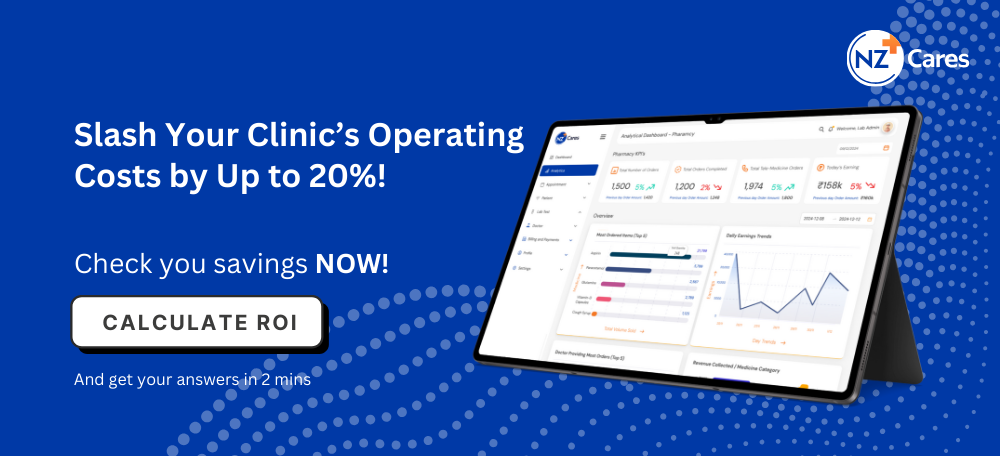Healthcare bosses deal with tight budgets, piles of paperwork, and patients who want quick, quality care. Besides, patients now expect speedy check-ins, easy billing, and great treatment.

Add tough rules and the push for digital healthcare, and hospitals feel the heat to step up their services. And what’s the solution to this?
An AI-Powered Hospital Management Systems can kickstart a boost in efficiency, changing how hospitals work, but picking the wrong tool can burn cash and stress out teams.
Take hospital scheduling software as it spots busy times and sets up staff shifts smoothly, cutting extra hours and keeping teams happy.
The rewards are big: AI-powered hospital management systems could save healthcare $150 billion a year by reducing admin work, and save up to $200 billion from fake claims.
To give you the clarity, this blog highlights seven clever ways to utilise AI-powered hospital management systems to save big on cost cuts and free up staff time while providing patient-focused care.
7 Smart Ways AI-Powered Hospital Management Systems Cut Costs and Boost Efficiency
1. Automating Administrative Tasks to Reduce Overhead
Hospitals drown in paperwork and billing tasks that sap staff energy and inflate budgets. AI-powered hospital management systems take this job to tackle this mess by automating repetitive tasks that saves crucial time and money.
How It Works
AI transforms administrative tasks by handling documentation and billing with pinpoint precision. For documentation, hospital information management systems use natural language processing (NLP) to transcribe doctor-patient conversations and organize notes instantly.
These systems sync with hospital database management systems, updating patient records in real time and cutting manual errors that lead to costly rework.
Billing gets a major upgrade with AI-Powered Hospital Management Systems. They scan patient records to assign accurate medical codes and spot mistakes before claims hit payers.
This automation ensures claims sail through, reducing denials and speeding up cash flow.
- Smart Transcription: NLP captures and sorts clinical notes, populating hospital EMR effortlessly.
- Coding Accuracy: AI assigns precise billing codes, matching diagnoses and procedures.
- Error Checks: Automated scans catch coding or data entry mistakes, saving crucial rework time.
Key Benefits
Automation delivers big wins for hospitals, trimming costs and easing staff burdens:
- Time Savings: Clinicians shave hours off daily paperwork, spending more time with patients.
- Lower Costs: Fewer claim denials mean faster reimbursements and leaner budgets.
- Happier Staff: Less admin stress boosts morale and cuts burnout.
- Seamless Data: Integration with hospital CRM ensures patient info flows smoothly across teams.
Case Study: Apollo Hospitals
Apollo Hospitals in India rolled out an AI driven hospital management system to tackle documentation overload. Using NLP tools, it reduced clinicians’ paperwork time by 2–3 hours daily, letting them focus on patients. It not only increased apollo’s efficiency but reduced administrative cost up to 15% saving them millions yearly.
2. Optimizing Staff Scheduling and Reducing Overtime
No matter doctor, nurse, or front desk, everyone at the hospital has chaotic schedules that are difficult to manage and often leads to burnout which affects staff morale and care quality. Using smart predictions to craft schedules that match patient needs. Tools like hospital information management systems streamline shifts, cut extra hours, and keep teams happy, saving costs and boosting care quality.
How It Works
Hospital management systems analyze past patient inflow, seasonal trends, and real-time data to build efficient schedules.
By predicting busy periods, these systems ensure enough staff are on hand without overstaffing, reducing costly overtime. Integration with hospital database management systems provides a clear view of staffing needs across departments.
Besides, workforce management gets a lift with AI’s ability to spot mistakes and suggest fixes.
For instance, if an emergency room surge looms, the system can reassign staff or call in backups, avoiding last-minute scrambles.
- Demand Forecasting: AI predicts patient rushes, aligning shifts with need.
- Shift Optimization: HMS balances workloads, minimizing overtime.
- Real-Time Adjustments: AI flags staffing shortages, enabling quick fixes.
Key Benefits
AI hospital scheduling software delivers major advantage for hospitals:
- Cost Savings: Reduced overtime slashes payroll expenses significantly.
- Happier Teams: Balanced shifts boost morale and cut fatigue.
- Better Care: More staff time for patients improves outcomes.
- Emergency Readiness: AI ensures on-call staff are ready for crises.
Case Study: Cera Care
Cera Care, a UK healthcare provider, developed an AI Scheduler that cut administrative time by 80% and travel time by 50%, freeing staff to deliver two extra hours of care daily. It saved £1.2 million annually by reducing overtime, proving AI’s ability to transform workforce efficiency.
3. Enhancing Patient Flow and Reducing Length of Stay
AI-Powered Hospital Management Systems clear bottlenecks such as clogged hospital wards and long patient stays drive up costs and strain staff.
They optimise patient flow to save time and money through real-time bed management and quick discharge procedures to cut unnecessary stays. Keeping patients satisfied while easing the load on micro hospital resources.
How it Works
AI transforms patient flow by tracking bed availability and predicting discharge times with precision. Hospital EMR systems monitor occupancy in real time, using patient health analysis data to update bed statuses.
Such analytics ensures beds are ready for new patients, especially in micro hospitals with limited capacity.
Discharge planning gets a boost from AI’s predictive analytics, which analyze vital signs, lab results, and recovery progress to flag patients ready to leave, reducing costly extended stays.
- Bed Tracking: AI monitors occupancy, ensuring quick turnover.
- Discharge Predictions: Analytics identify patients fit for discharge.
- Queue Management: Virtual systems reduce waiting room congestion.
Key Benefits
AI-driven patient flow optimization delivers major savings and staff relief:
- Cost Savings: Shorter stays reduce bed and resource expenses.
- Staff Efficiency: Faster turnover frees nurses for critical tasks.
- Patient Satisfaction: Quicker admissions and discharges boost experience.
- Resource Allocation: Integrate with existing hospital crm optimize bed assignments.
Case Study
The Adelaide Score, an AI tool used in South Australian hospitals, streamlined patient flow by predicting discharge readiness. Integrated with hospital CRM systems, it cut hospital stays by 6.5%, saving $750,000 in four weeks which is equivalent to savings of $10 millions.
4. Reducing Diagnostic Errors and Unnecessary Tests
Misdiagnoses and redundant tests inflate hospital bills and delay care. Therefore, to tackle this, HMS uses diagnostic accuracy analysis and reduces additional procedures.
With smart decision support and test management, these systems helped save costs, reduce stress, and improve test outcomes.
How It Works
AI enhances diagnostics through clinical decision support systems analyzing patient data against vast medical databases.
Hospital management systems deliver evidence-based recommendations to clinicians, spotting subtle patterns in symptoms or imaging that might be missed, reducing errors that lead to costly follow-ups.
The system also cross checks patient history and guidelines to prevent unnecessary scans.
- Decision Support: AI suggests accurate diagnoses based on data.
- Test Filtering: Algorithms block unneeded tests, cutting waste.
- Data Integration: Unified patient records prevent repeat testing.
Key Benefits
AI-driven diagnostics yield significant advantages for hospitals:
- Cost Reduction: Fewer unnecessary tests slash lab and imaging expenses.
- Time Savings: Accurate diagnoses speed up treatment planning.
- Staff Relief: Reduced test backlogs ease radiologist and lab workloads.
- Better Outcomes: Precise diagnostics improve patient recovery rates.
Case Study: Gold Coast University Hospital
Gold Coast University Hospital in Australia used an AI-powered hospital ERP system to streamline diagnostics.
The HMS prioritized urgent scans and filtering unnecessary ones, it cleared a backlog of 54,000 images, saving $1.5 million annually. This reduced staff overtime and improved patient care timelines.
5. Automating Supply Chain and Inventory Management
Stockpiles of unused supplies or sudden shortages disrupt hospital operations, inflate expenses, and frustrate staff. But the hospital management system gives extensive understanding of supply management.
It predicts supply needs with precision and automates purchasing without waste, saving millions and freeing staff for patient care.
How It Works
With accurate dashboard insights, AI-Powered Hospital Management Systems studies supply demands by analyzing patient volumes, procedure schedules, and historical usage. It maintains balanced stock levels, avoiding overstocking as well as shortages.
Technologies like RFID tags and barcode scanners track items in real time, so staff can instantly locate supplies, slashing time spent searching.
It finds cost-effective suppliers, triggers orders at optimal times, and flags expiring items for use, keeping the supply chain agile and responsive.
- Usage Forecasts: AI predicts supply needs accurately.
- Smart Ordering: Auto-triggers purchases to avoid shortages.
- Live Tracking: RFID ensures real-time inventory visibility.
Key Benefits
- Huge Savings: Less waste and better deals cut costs.
- Time Efficiency: Staff avoid manual inventory checks.
- Reliable Supplies: Critical items are always ready.
- Accurate Records: Automated data reduces errors.
Case Study: AI-RTLS in Action
In one of the most compelling examples, a 500-bed hospital implemented AI-RTLS for asset tracking and inventory control. The results were eye-opening:
- Annual savings of $3–5 million
- Significant reduction in staff time spent locating equipment
- Improved asset utilization and reduced equipment loss
6. Enhancing Revenue Cycle Management
Slow payments and rejected claims are the major reasons that affect hospital funds. Additionally, ROI also gets affected leading hospitals to restructure their operations and reduce staff.
HMS avoids this through various tasks. It automates claims, catches errors, and predicts financial trends.
How It Works
The hospital management system pulls accurate data from patient records and codes to claims processing correctly.
It checks claims for mistakes before they reach insurers, cutting denials and getting money in faster, so billing teams aren’t stuck chasing fixes.
The system also studies revenue patterns and payer habits to offer clear financial insights. This helps hospitals plan budgets wisely and spot ways to save, keeping finances steady and strong.
- Quick Claims: AI sends clean claims in a flash.
- Error Catcher: Spots issues before claims fail.
- Smart Forecasts: Predicts cash trends for better planning.
Key Benefits
- Speedy Cash: Fast claims mean quicker payments.
- Less Waste: Fewer denials save rework costs.
- Staff Ease: Billing teams handle fewer headaches.
- Clear Plans: Revenue insights shape smart budgets.
Case Study
Mount Sinai Health System deployed a dynamic AI-powered hospital management system to overhaul revenue cycle tasks.
Large language models (LLMs) efficiently bundled 50 clinical processes, from trial matching to safety checks, cutting API costs by 17x times.
Final outcome:
- Massive Savings: Millions saved annually via reduced API expenses.
- Staff Relief: Billing teams freed for high-priority tasks.
- Reliable Performance: LLMs handled heavy workloads without accuracy loss.
7. Supporting Remote Patient Monitoring and Telehealth
AI-powered hospital management systems cut costs and save staff time through reducing hospital readmissions and in-person visits.
With smart remote monitoring and telehealth tools, these systems track health data and enable virtual care, lowering expenses and freeing up staff for better patient care.
How It Works
AI-Powered Hospital Management Systems uses AI to monitor patients remotely. It collects data from wearables, like heart rate or blood sugar monitors, and sends alerts to doctors if something’s off. This helps catch problems early, especially in micro hospitals with fewer staff.
For telehealth, AI reviews patient data during virtual visits and updates hospital CRM. Suggesting treatment plans based on symptoms and history, making remote care as good as in-person visits while saving time.
- Health Tracking: AI watches vitals around the clock.
- Virtual Visits: Telehealth supports remote check-ups.
- Timely Alerts: Flags issues for quick action.
Key Benefits
- Lower Costs: Fewer readmissions save big bucks.
- Less Work: Remote monitoring cuts in-person demands.
- Wider Reach: Telehealth serves far-off patients.
- Stronger Health: Early fixes boost recovery.
Case Study: Remote Patient Monitoring Programs
A 2021 study by PJ Devereaux and Michael McGillion evaluated remote patient monitoring (RPM) for post-surgical care.
It divided 905 patients into two groups: one with standard care and another using RPM with at-home vital sign devices. These devices sent data to a Clinician Portal, allowing remote oversight and communication via text, chat, or video.
The study revealed notable improvements:
- Medication Errors: RPM identified 30% more errors than standard care.
- Pain Levels: Patients reported 10-14% less pain with RPM.
- Readmissions: Hospital readmissions dropped by 5%.
Conclusion
Let’s face it, hospitals weren’t built to deal with paperwork, do claims, or sit on spreadsheets. They’re meant to heal, help, and move fast when it counts.
And that’s exactly what AI-powered hospital management systems are doing, they are clearing the clutter, cutting the waste, and giving time back to the people who need it most. These strategies not only reduce financial burdens but also improve patient care and staff satisfaction.

